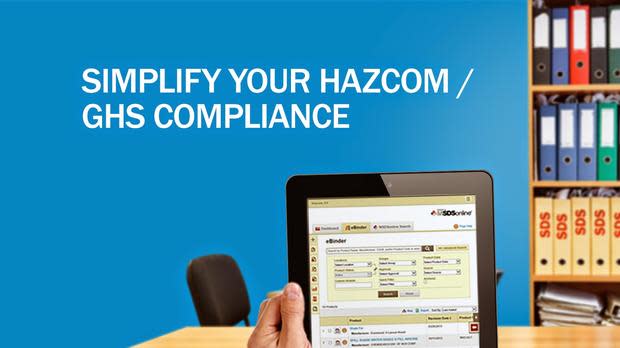Meet hazmat compliance deadlines without hiring extra staff by using SaaS apps

Image: MSDSonline
More and more hazardous materials are imported and stored at manufacturing plants while in transit between plants and warehouses or workplaces. To ensure workplace safety for employees, companies must comply with state, federal, and international regulations on hazmat labeling and reporting requirements.
These companies use material safety data sheets (MSDSs) to classify hazardous materials, to document safe handling procedures of those materials, and to prioritize actions first responders must take when responding to emergencies related to those materials. If companies don't properly record details in MSDSs, they may face the consequences of noncompliance.
Potential consequences of noncompliance
An accident of spilling a hazardous chemical material in the air or on land will result in significant consequences for executives and workers. Not only does productivity go down, but the company will likely suffer loss of revenues due to a sudden jump in insurance costs. The company may ultimately face high litigation costs, prohibitive fines, and loss of reputation for noncompliance.
To avoid these consequences, executives must comply with labeling and reporting requirements mandated by the U.S. Department of Labor's Occupational Safety & Health Administration (OSHA).
OSHA's requirements
OSHA has adopted the United Nations Globally Harmonized System of Classification and Labelling of Chemicals (GHS). OSHA requires chemical manufacturers, oil/gas, transportation, healthcare, construction, and other industries in the US to reclassify all hazard chemicals using GHS's criteria no later than June 1, 2015. Another daunting task is that they must reformat every MSDS into 16 sections.
Consider using an SaaS app to be in compliance
To meet OSHA's demands for reclassification and reformatting, many organizations are opting to use a Software as a Service (SaaS) app to save the upfront costs of hiring additional staff. To help determine which app is the best fit for your organization, you should consider these comparison criteria:
How the app can meet your functional requirements.
How large of a database the app can handle.
How many users can concurrently access the app.
How well the app can integrate with one or more ERP systems.
How well the app can scale when there is an upsurge in demand for information on workplace safety, hazardous materials, and actions to take in response to spills, overexposure, and other accidents.
Whether the app can be used by US companies doing business outside of the US. Note: OSHA rules and US state regulations do not apply to these companies.
MSDSonline apps
MSDSonline offers a wide range of SaaS apps, including:
HQ Account helps midsize and large organizations track and manage chemical hazards in the workplaces. It also provides guidance on implementing safe handling procedures.
HQ RegXR Account provides the regulatory cross-referencing engine (as an addition to the HQ Account). It flags chemical hazards that appear on regulated state, federal, and international hazardous substance lists, making it easier to comply with SARA Title III, EPA Tier II, and other regulatory reporting requirements.
MSDSonline Mobile manages MSDS/chemical inventory and accesses and deploys safety data sheets.
Plan1 First Responder Share Service allows first responders access to information about the hazardous chemicals they may encounter when responding to emergencies. MSDSonline customers with an HQ Account or HQ RegXR Account can get this app for free.
Chemical Spill Response & Reporting helps first responders collaborate on incident and spill resolution reports.
Actio's Regulator
Actio's Regulator tracking tracks and manages in real-time an enterprise's hazardous chemical inventory. It generates regulatory reports to help the international companies comply with global regulations, including GHS, EPA, REACH, Restrictions of Hazardous Substances (RoHS), and Korea REACH.
This SaaS offering gets inbound inventory for linkage with Oracle, SAP, Microsoft Dynamics AX, or any other ERP system. When Regulator gets new materials, it generates HAZCom-compliant chemical container labels.
Accenture's vertical add-ons
Accenture integrates chemical inventory management with SAP Business ByDesign, which targets small businesses, midsize organizations, and subsidiaries of large enterprises. SAP Business ByDesign helps them to collaborate international compliance regulations as well as marketing, sales, financing, and procurement.
Accenture incorporated five vertical add-ons into the ERP SaaS for the chemical industry:
Batch management and determination (during production cycles)
Product cost and variance analysis of complex chemical mixes
Internal subcontracting to meet the needs of mid-tier companies
Order and stock reporting to provide inventory across the supply chain
Hazardous materiel classification in response to a variety of mandatory regulations
Summary
To deliver hazmat reports by compliance deadlines, your best bet is to use SaaS apps. Remember to use the comparison criteria to choose apps that meet your needs.
Also read
Apple halts use of two harmful chemicals in iPhone assembly (CNET)
What IT pros should know about exposure to hazardous materials
Disclaimer: TechRepublic and CNET are CBS Interactive properties.

